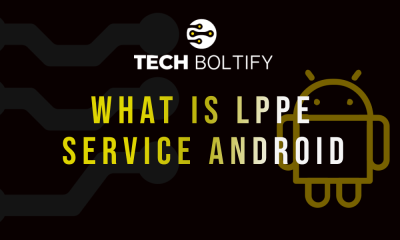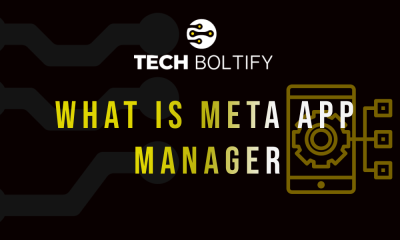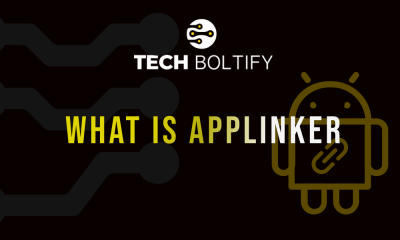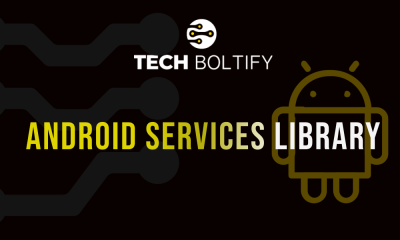Tech
Best Blue Light Filter Apps For iOS & Android

Best Blue Light Filter Apps for iOS & Android – Complete Guide
Are your eyes feeling strained from excessive use of your phone, tablet, or computer screen? Do you wish to make your eyes more comfortable, especially when using your phone before bedtime? The solution lies in a blue light filter!
With people spending more than 7 hours a day staring at electronic screens, it’s no wonder that 68% of individuals experience difficulty sleeping due to disrupted sleep patterns caused by exposure to blue light.
Continuous exposure to blue light can have negative effects on the eyes, often leading to visual impairment. Additionally, prolonged screen time is known to trigger headaches and insomnia.
But what if you need to work late into the night on your screen? Fortunately, the digital world offers a solution for you too! To protect your eyes, ensure smooth workflow, and maintain productivity during late-night screen work, consider using blue light filter apps.
Best Blue Light Filter Apps
As per the American Optometric Association, a staggering 90% of individuals spend over two hours daily on digital devices. Such prolonged screen time exposes the eyes to blue light, often resulting in discomfort.
Furthermore, blue light exposure in the evening can deplete energy levels more quickly, leading to disturbances in sleep patterns. Consequently, incorporating blue light filters can enhance productivity by 10-15% when using smartphones, laptops, and tablets.
While some devices like iPhones come with built-in blue light filter settings, and high-quality Android devices offer similar functionality, achieving exceptional results at night may necessitate the use of specialized blue light-blocking apps.
Blue light filter apps serve as an excellent solution for Android, iOS, and Windows users seeking to mitigate the effects of blue light exposure. These apps are readily available on the Google Play Store and Apple App Store, offering customizable settings to suit individual preferences.
By effectively reducing blue light intensity, these apps not only safeguard the eyes but also deliver optimal results for smartphone usage. Here are some of the best blue light filter apps for iOS, Android, and Windows users.
Blue Light Filter App for Android – Night Mode
The blue light filter Night Mode, boasting a stellar 4.8-star rating and over 10 million downloads, stands out as the premier choice for Android users. Originally launched in July 2016, it continues to receive updates compatible with Android versions 4.4 and up. Designed to safeguard users’ eyes during phone usage, this application effectively diminishes the intensity of blue light emitted from mobile screens, transitioning it into a soothing, natural sunlight color.
Upon installation, users encounter a convenient sliding button interface, allowing them to tailor the filter intensity to their individual eye comfort preferences with a simple swipe.
Moreover, the night mode feature dynamically adjusts screen brightness, enabling prolonged smartphone usage without causing strain. Additionally, an auto-timer functionality facilitates time management, enhancing productivity during extended usage sessions.
One notable advantage of this app is its minimal impact on battery health, as the natural light emulation consumes minimal power. Furthermore, the built-in screen dimmer intelligently regulates brightness levels to further optimize user comfort.
Note: What is Quickstep Android
Key Features
- > No requirement for an additional anti-glare screen filter
- > Provides an amber color mode conducive to restful sleep
- > Easy adjustment of brightness and color temperature settings
- > Instant activation and deactivation for seamless user experience
Blue Light Filter On Android – Eye Care
The Blue Light Filter, also included in the best blue light filter apps for Eye Care app, boasting a commendable 4.5-star rating and over 500 thousand downloads, prioritizes customized settings tailored to safeguarding eye health.
Initially introduced in February 2017, its subsequent updates are compatible with Android versions 4.0.3 and above. Its primary function revolves around mitigating eye fatigue through a natural and comfortable eye strain filter.
In environments with reduced lighting, such as during nighttime usage, prolonged screen exposure can exert undue strain on the eyes. However, upon activation, this app seamlessly adapts to ambient light conditions, automatically transitioning to a yellow light filter in dim settings to counteract the effects of blue light.
Furthermore, the implementation of natural brightness not only enhances user comfort but also contributes to minimize battery consumption. Notably, all these features operate discreetly in the background, ensuring that no app logo appears in screenshots.
Key Features of Blue Light Filter App
- Offers various color schemes, including Gold, Pink, Macaron Green, and Mystic Purple
- Mitigates glare to prevent eye strain
- Supports multitasking by allowing users to run multiple apps simultaneously in the background
- Facilitates easy deactivation with a single swipe in the morning
F.lux
The F.lux app, boasting a commendable 4.1-star rating and garnering over 1 million downloads on the Google Play Store, serves as a solution for mitigating the effects of bright blue colors on devices running Android 4.0.3 and above.
Initially introduced in March 2016, its primary functionality extends beyond Android devices, proving more effective on computers due to its array of remarkable features.
F.lux Blue Light offers users a plethora of temperature variations, with warm light and sunlight being particularly beneficial during daylight hours, minimizing strain on the eyes.
Its automatic adjustment feature gradually transitions the screen to warmer colors as night falls, facilitating better sleep quality for individuals spending prolonged periods in front of screens.
However, one notable drawback of this app is its requirement for a rooted phone, limiting its accessibility to certain devices, particularly older models of Samsung smartphones. Additionally, while a preview version exists for F.lux on Android, its functionality on iPhones is somewhat limited, whereas F.lux for Windows operates seamlessly across all Windows computers.
Distinctive Features
- Blue light filter App for Android easily supported on devices running Lollipop and Marshmallow versions of Android
- Compatibility with Kitkat devices is achievable through proper rooting procedures
- Automatic reversion to normal color settings in daylight conditions
Twilight: Blue Light Filter App
The Twilight Night Light app boasts an impressive track record, evidenced by its thousands of positive user reviews, averaging a stellar 4.5-star rating on the Google Play Store and amassing over 10 million downloads. Such widespread acclaim speaks volumes about its efficacy in mitigating blue light exposure and enhancing eye comfort.
Notably, the Twilight app introduces a red light filter, renowned for its longer wavelength and lower energy, making it particularly conducive for use before bedtime.
In contrast, the high-energy blue light, prevalent in many screens, can disrupt sleep patterns if exposed to for extended periods, making a gentle and subdued red filter an optimal choice for preserving ocular health.
Furthermore, the app offers customizable brightness settings to cater to individual preferences and eye sensitivities.
It is under the category of best blue light filter apps as, Its adaptive functionality automatically adjusts light intensity based on predetermined schedules and the current time on the smartphone, aligning seamlessly with natural sleep-wake cycles.
Distinctive Features
- Strict adherence to user privacy with no collection of personal information
- Potential to extend the lifespan of AMOLED screens
- Maintains a cool screen temperature owing to the lower energy of red light
- Provides a comfortable viewing experience for nighttime reading and movie watching
Blue Light Filter and Night Mode
This light application has garnered widespread acclaim, boasting thousands of positive user reviews and an impressive average rating of 4.5 stars on the Google Play Store, with over 1 million downloads.
Renowned for its versatility, the app excels in various scenarios, whether it be reading, engaging in airplane mode gaming, or perusing the latest news articles, all made possible through its array of customizable color modes.
Offering a luminous flux that ranges from high to minimal, the app provides a selection of soft colors accompanied by dim lighting, which proves beneficial for the optic nerve without imposing any negative effects on the eyes.
What sets this blue light app apart is its advanced RGB customization feature, allowing users to adjust red, green, or blue hues according to their individual comfort preferences. Additionally, users can choose from a range of brightness options, including bright, medium, dark, ultra dark, and no tint, all aimed at optimizing battery conservation.
The app further streamlines user experience with an automatic turn on/off option accessible via the notification bar, thereby saving valuable time.
Moreover, users have the flexibility to design their own night shift schedules, ensuring automatic activation and deactivation according to their specified timings. While numerous blue light filtering apps exist, this particular one stands out as the premier choice for Android phones, thanks to its comprehensive range of features.
Distinctive Features
- Customize and save personalized filters
- Achieve up to 15% battery savings
- Compatible with 7 and 10-inch tablets for enhanced versatility
HALO – Blue Light Filter on Android
The Halo app, designed for blue light filtering, boasts an average rating of 3.8 stars on the Google Play Store and has garnered over half a million downloads. Compatible with Android versions 7.0 and up, this app introduces unique features not found in other blue light filtering applications.
One standout feature is the ability to toggle the mode on or off simply by rotating the mobile device, such as flipping it upside down (180˚) to activate night mode. Additionally, the app can be set to activate automatically at a scheduled time, ideal for when you’re lying in bed.
Furthermore, the app seamlessly resumes its operations with the saved settings after a mobile device restarts. Its night shift feature, supported by four filter colors, including a reddish hue, effectively blocks blue light to protect the eyes during nighttime use on Android devices.
Distinctive Features
- Option for quick On/Off accessible from the top bar
- Convenient access to settings with a single tap from the notification panel
- Night mode activation by rotating the device to either the right side (90˚) or left side (270˚)
- Available for download on Android and iOS platforms
Eye Protect Blue Light Filter
It is a popular application available on the Google Play Store, boasting an impressive average rating of 4.5 stars and garnering over 100 thousand downloads since its release in 2020.
Compatible with Android versions 5.0 and up, it has gained recognition among both Android and iOS users for its array of filters and user-friendly display options.
What sets it apart from similar apps designed for PC use are its advanced functionalities aimed at safeguarding users’ eyes from the harmful effects of blue light emitted by screens, making it a go-to solution for eye strain prevention.
One of its primary advantages lies in its simplicity and effectiveness in mitigating blue light radiation, offering users a strain-free experience. Additionally, its blue screen filter has been reported to improve sleep quality by 10-20% during nighttime usage.
Key features
- Stress mode filters, which help alleviate eye fatigue.
- Overlay filters that can be easily applied to tailor the display to individual preferences.
- Rest light mode with reduced intensity.
Night Shift Automatic – Blue Light Filter App for iPhone
It is a feature predominantly available to iOS and macOS users. It was introduced to iOS devices starting from iOS 9.3 versions in 2015 and later extended to Mac systems in 2017, gaining widespread adoption among millions of Apple users.
Activation is straightforward, accessible from the settings menu under the display section, allowing users to toggle it on or off. Users can specify preferences such as scheduling, enabling automatic functionality based on location and time, or opt for manual control.
Furthermore, users can customize their experience by selecting color filters from the tint section, adjusting the warmth of the chosen color with a simple slide gesture. This enables users to personalize their display with warmer or cooler tones according to their preferences, leveraging the built-in settings for optimal comfort.
With the advanced features integrated into the latest smartphones, such as built-in filters, remove the blue light from iPhone, the necessity for additional blue light filters for iPad and other iOS devices is arguably diminished. Leveraging the existing advanced features is generally recommended for users seeking effective blue light filtering solutions.
Key features
- Night Shift Automatic include automatic switching between sunset and sunrise modes
- Additionally, users have a wide array of color combinations to choose from, including orange, green, yellow, red, brown, pink, and more.
Night Shift Automatic is available for download on both Android and iOS platforms.
Iris
It is a versatile application available across multiple platforms, including Windows, Mac, Linux, Android, and iOS devices. Its adaptability is a significant advantage, allowing users to adjust screen color timings and access various customization.
Key features
- Color temperature and brightness.
- Iris is not offered as a free service
Redshift
Redshift, akin to f.lux, is a laptop application designed for blue light filtering. It intelligently considers your geographic location to calibrate the screen’s color temperature automatically.
Upon installation, users will notice distinct color variations between daytime and nighttime. However, the transitions from natural to warmer hues are seamless. This gradual adjustment aids in eye comfort and can facilitate better sleep quality without immediate awareness.
To acquire Redshift, you can download it from: Redshift
Conclusion
A recommended choice for Android users is the Blue Light Filter iPhone – Night Mode app, acclaimed for its excellent reviews and ratings. On the other hand, iOS users can benefit from night shift and flux iPhones as viable options.
Furthermore, there exists a multitude of blue light filter software options for PC, including Linux blue light filter Linux, computer screen blue light filter, chrome blue light filter, and flux for PC, among others.
Each of the aforementioned apps is extensively discussed to assist users in making an informed decision. Select the appropriate option for your Android, iOS devices, or Windows system to safeguard your eyes from strain and fatigue.
FAQs
How can I Reduce Blue Light on my iPhone?
Simply follow these steps: Open Settings > Tap on Display & Brightness > Select Night Shift > Enable Night Shift > Notice the screen becoming warmer in color > Adjust Color Temperature by dragging the slide for changing intensity. This is how you can effectively block blue light on your iPhone.
Does Night Shift Block Blue Light?
Absolutely, it’s one of the most beneficial features for night readers. Once activated, Night Shift on the iPhone effectively blocks blue light emission, thanks to the red light filter feature.
Should I Keep Using a Blue Light Filter All the Time?
While using a blue light filter can significantly improve sleep quality and reduce eye strain during evening and nighttime screen use, some users prefer using it throughout the day for additional comfort. However, it’s recommended to temporarily disable the filter for tasks requiring precise colors.
Tech
How To Bridge Front-End Design And Backend Functionality With Smarter API Strategy
Introduction: Building More Than Just Screens
We’ve all seen apps that look sharp but crumble the moment users push beyond the basics. A flawless interface without strong connections underneath is like a bridge built for looks but not for weight. That’s why APIs sit at the heart of modern software. They don’t just move data; they set the rules for how design and logic cooperate. When APIs are clear, tested, and secure, the front-end feels smooth, and the backend stays reliable.
The reality is that designing those connections isn’t just “coding.” It’s product thinking. Developers have to consider user flows, performance, and future scale. It’s about more than endpoints; it’s about creating a system that’s flexible yet stable. That mindset also means knowing when to bring in a full-stack team that already has the tools, patterns, and experience to move fast without cutting corners.
Here’s where you should check Uruit’s website. By focusing on robust API strategy and integration, teams gain the edge to deliver features user’s trust. In this article, we’ll unpack how to think like a product engineer, why APIs are the real bridge between design and functionality, and when it makes sense to call in expert support for secure, scalable development.
How To Define An API Strategy That Supports Product Goals
You need an API plan tied to what the product must do. Start with user journeys and map data needs. Keep endpoints small and predictable. Use versioning from day one so changes don’t break clients. Document behavior clearly and keep examples short. Design for errors — clients will expect consistent messages and codes. Build simple contracts that both front-end and backend teams agree on. Run small integration tests that mimic real flows, not just happy paths. Automate tests and include them in CI. Keep latency in mind; slow APIs kill UX. Think about security early: auth, rate limits, and input checks. Monitor the API in production and set alerts for key failures. Iterate the API based on real use, not guesses. Keep backward compatibility where possible. Make the API easy to mock for front-end developers. Celebrate small wins when a new endpoint behaves as promised.
- Map user journeys to API endpoints.
- Use semantic versioning for breaking changes.
- Provide simple, copy-paste examples for developers.
- Automate integration tests in CI.
- Monitor response times and error rates.
What To Do When Front-End and Backend Teams Don’t Speak the Same Language
It happens. Designers think in pixels, engineers think in data. Your job is to make a shared language. Start by writing small API contracts in plain text. Run a short workshop to align on fields, types, and error handling. Give front-end teams mocked endpoints to work against while the backend is built. Use contract tests to ensure the real API matches the mock. Keep communication frequent and focused — short syncs beat long meetings. Share acceptance criteria for features in user-story form. Track integration issues in a single list so nothing gets lost. If you find repeated mismatches, freeze the contract and iterate carefully. Teach both teams basic testing so they can verify work quickly. Keep the feedback loop tight and friendly; blame only the problem, not people.
- Create plain-language API contracts.
- Provide mocked endpoints for front-end use.
- Contract tests between teams.
- Hold short, recurring integration syncs.
- Keep a single backlog for integration bugs.
Why You Should Think Like a Product Engineer, Not Just A Coder
Thinking like a product engineer changes priorities. You care about outcomes: conversion, help clicks, retention. That shifts API choices — you favor reliability and clear errors over fancy features. You design endpoints for real flows, not theoretical ones. You measure impact: did a change reduce load time or drop errors? You plan rollouts that let you test with a small cohort first. You treat security, observability, and recoverability as product features. You ask hard questions: what happens if this service fails? How will the UI show partial data? You choose trade-offs that help users, not just satisfy a design spec. That mindset also tells you when to hire outside help: when speed, scale, or compliance exceeds your team’s current reach. A partner can bring patterns, reusable components, and a proven process to get you shipping faster with less risk.
- Prioritize outcomes over features.
- Measure the user impact of API changes.
- Treat observability and recovery as product features.
- Plan gradual rollouts and feature flags.
- Know when to add external expertise.
How We Help and What to Do Next
We stand with teams that want fewer surprises and faster launches. We help define API strategy, write clear contracts, and build secure, testable endpoints that front-end teams can rely on. We also mentor teams to run their own contract tests and monitoring. If you want a quick start, map one critical user flow, and we’ll help you design the API contract for it. If you prefer to scale, we can join as an extended team and help ship several flows in parallel. We stick to plain language, measurable goals, and steady progress.
- Pick one key user flow to stabilize first.
- Create a minimal API contract and mock it.
- Add contract tests and CI guards.
- Monitor once live and iterate weekly.
- Consider partnering for larger-scale or compliance needs.
Ready To Move Forward?
We’re ready to work with you to make design and engineering speak the same language. Let’s focus on one flow, make it reliable, and then expand. You’ll get fewer regressions, faster sprints, and happier users. If you want to reduce risk and ship with confidence, reach out, and we’ll map the first steps together.
Tech
Which SEO Services Are Actually Worth Outsourcing? Let’s Talk Real-World Wins
Okay, raise your hand if you thought SEO just meant stuffing keywords into blog posts and calling it a day. (Don’t worry, we’ve all been there.) Running a business comes with enough hats already, and when it comes to digital stuff, there’s only so much you can do on your own before your brain starts melting. The world of SEO moves quick, gets technical fast, and—honestly—a lot of it’s best left to the pros. Not everything, but definitely more than people expect. So, let’s go through a few of those SEO services you might want to hand off if you’re looking to get found by the right folks, minus the headaches.
Technical SEO—More Than Just Fancy Talk
If you’ve ever seen a message saying your website’s “not secure” or it takes ages to load, yeah, that’s technical SEO waving a big red flag. This stuff lives under the hood: page speed, mobile-friendliness, fixing broken links, and getting those little schema markup things in place so search engines understand what the heck your pages are about.
You could spend hours (days) learning this on YouTube or DIY blogs, but hiring a specialist—someone who does this all day—saves you a load of stress and guesswork. Sites like Search Engine Journal dig into why outsourcing makes sense, and honestly, after one too many late-night plugin disasters, I’m convinced.
Content Writing and On-Page Optimization (Because Words Matter)
Let’s not dance around it: great content still rules. But search-friendly content is a different beast. It needs to hit the right length, work in keywords naturally, answer genuine questions, and actually keep visitors hooked. Outsourcing writing, especially to someone who actually cares about your brand’s tone, is worth it for most of us.
On-page SEO, which is tweaking all those little details like titles, descriptions, internal links, and image alt text, is a time-eater. It’s simple once you get the hang of it, but when you’re trying to grow, outsourcing makes the most sense.
Link Building—Trickier Than It Looks
Here’s where things get a bit spicy. Backlinks are essential, but earning good ones (not spammy or shady stuff) takes relationship-building, tons of outreach, and real patience. You can spend all month sending emails hoping someone will give your guide a shout-out, or you can just hire folks with connections and a process. Just watch out for anyone promising “hundreds of links for dirt cheap”—that’s usually a shortcut to trouble.
Local SEO—Getting Seen in Your Own Backyard
Ever tried showing up for “pizza near me” only to find yourself on page 7? Local SEO isn’t magic, but it takes a special touch: optimizing your Google Business Profile, gathering reviews, and making sure your info matches everywhere. It’s honestly a job in itself, and most small teams find it way easier to have a local SEO pro jump in a few hours a month.
Reporting and Analytics—Don’t Go Blind
Last, don’t skip out on real reporting. If nobody’s tracking what’s working—and what’s not—you’re just flying blind. Outsourced SEO pros come armed with tools and real insights, so you can see if your money’s going somewhere or just swirling down the drain.
Wrapping Up—Be Realistic, Outsource Smarter
You’re good at what you do, but SEO is more like ten jobs rolled into one. Outsource the parts that zap your time or make your brain itch, and keep what you enjoy. Focus on the wins (more leads, higher rankings, fewer headaches), and watch your business get the attention it deserves.
Tech
White-Label SEO: Building Scalable Digital Marketing Partnerships
Table of Contents
- What Is White-Label SEO?
- Why Digital Agencies Choose White-Label Solutions
- How White-Label SEO Works in Practice
- Benefits for Small and Mid-Sized Agencies
- Risk Management and Quality Assurance
- White-Label SEO and Client Retention
- What to Look for in a White-Label SEO Partner
- Future Trends in White-Label SEO
What Is White-Label SEO?
White-label SEO refers to a business arrangement where an agency partners with a third-party provider to deliver SEO services under the agency’s own brand. Unlike traditional outsourcing, where the client may be aware of third-party involvement, white-label models ensure the service provider remains invisible to the end client. The agency retains control over client communication and branding while benefiting from the expertise and tools of seasoned SEO professionals.
This structure allows agencies to offer complete SEO solutions without needing deep in-house expertise, staffing, or technology. For those looking to deliver robust results while maintaining their branding, leveraging an established provider such as SEO white label by Vazoola is a popular route. As demand for scalable and specialized SEO services grows, white-label partnerships have become a cornerstone for forward-thinking digital marketing agencies.
Why Digital Agencies Choose White-Label Solutions
Agencies of all sizes frequently encounter resource constraints, particularly as clients ask for increasingly sophisticated services. Building an advanced SEO department in-house can be cost-prohibitive, requiring hiring, training, and constant adaptation to search engine algorithm changes. White-label solutions are attractive because they enable agencies to offer first-rate SEO without prohibitive investments.
Additionally, as the digital landscape evolves, clients seek integrated digital marketing strategies instead of disconnected services. With white-label SEO, agencies can rapidly expand their offerings, supporting their growth strategies while capturing a larger market share. This flexibility allows consultancies and digital agencies to remain competitive as demands for comprehensive solutions intensify.

How White-Label SEO Works in Practice
A typical white-label SEO partnership starts with thorough onboarding and aligning goals and processes between the agency and the provider. The agency submits client data and campaign objectives, while the provider crafts a tailored SEO strategy and implementation plan. Once campaigns are underway, the agency oversees communication with its clients, while the provider handles the technical execution—keyword research, link building, technical audits, or content creation.
White-label SEO providers support streamlined communication through client dashboards, branded reports, and regular performance updates. Consistent reporting helps agencies build trust and credibility with their clients without revealing the third-party provider. Workflow automation and transparency are central to success, as illustrated in case studies where agencies have seamlessly scaled from a handful to dozens of clients due to repeatable, managed processes. For further insights, consider Moz’s SEO Guide, a comprehensive resource on industry-accepted best practices.
Benefits for Small and Mid-Sized Agencies
White-label SEO is often a game-changer for small and mid-sized agencies because it equalizes the playing field with larger competitors. These agencies can deliver enterprise-grade SEO services by tapping into top-tier talent and technology while maintaining personalized client relationships. This versatility helps attract and retain clients who might otherwise gravitate toward major digital marketing firms.
Another key advantage is the ability to focus internal teams on their strengths, whether that’s account management, creative work, or strategy. Rather than spreading resources thin, agencies can direct their energy where it adds the most value. By outsourcing technical SEO, they reduce overhead and avoid the risks of hiring, training, and turnover.
Risk Management and Quality Assurance
A significant challenge in white-label SEO is ensuring consistent communication, maintaining transparency, and delivering dependable results. Agencies should adopt robust QA frameworks to monitor campaign progress, verify deliverables, and address issues promptly. Scheduled performance reviews, auditing tools, and transparent project management processes are essential to quality assurance.
To mitigate risks, agencies should establish transparent reporting systems and agree on milestones and metrics upfront. Following the guidance of established leaders like Moz can help agencies set clear expectations and implement best practices in all aspects of SEO campaign delivery.
White-Label SEO and Client Retention
Strong white-label partnerships foster long-term client retention. Agencies can consistently deliver value through outcome-focused campaigns—whether improving rankings, increasing organic traffic, or driving conversions. The ability to tap into a partner’s expertise and resources means agencies are better equipped to meet evolving client expectations and deliver measurable results over time.
The seamless integration of white-label services also allows agencies to provide end-to-end digital marketing solutions, reducing the need for clients to seek alternative providers.
What to Look for in a White-Label SEO Partner
Choosing the right white-label SEO partner is crucial. Agencies should prioritize experience, reputation, transparent processes, and technical scalability. A strong partner openly shares methodologies, provides real-time support, and can accommodate a growing client base without sacrificing quality or compliance.
Be wary of partners who promise rapid results without clear strategies, offer generic services, or lack documented reporting and quality control processes. Key questions to ask include: What is your approach to link building? How do you handle reporting and communication? What QA measures are in place? Review insights from trusted white-label news sources to compare industry-leading providers and inform your vetting process.
Future Trends in White-Label SEO
Automation, AI integration, and advanced analytics define the future of white-label SEO. Emerging tech platforms help streamline keyword research, content optimization, and reporting, delivering greater efficiency for agencies and their clients. As client expectations rise, providers focus on more sophisticated dashboards, granular analytics, and proactive strategic support.
Similarly, the partnership model is evolving. Agencies and white-label providers are moving toward deeper collaborations, with joint innovation and tailored solutions playing an increasing role. Agencies prioritizing adaptability and choosing forward-thinking partners will be best positioned to thrive in the changing landscape.
-
Tech1 year ago
AI and Freight Management
-

 Tech2 years ago
Tech2 years agoLPPe Service Android App and its Functions – How to Remove it
-

 Tech1 year ago
Tech1 year agoWhat is a Permission Controller – Control Manager Notifications
-

 Tech2 years ago
Tech2 years agoWhat is Device Keystring App On Android
-

 Tech2 years ago
Tech2 years agoWhat is Carrier Hub – How to Resolve Processing Requests Issues
-

 Tech2 years ago
Tech2 years agoWhat is Summit IMS Service – How to Stop Syncing on Your Android Device
-

 Tech2 years ago
Tech2 years agoMeta App Manager – What is Meta App Installer
-

 Tech2 years ago
Tech2 years agoWhat is Cameralyzer Samsung – How to Fix or Uninstall Cameralyzer on Android









